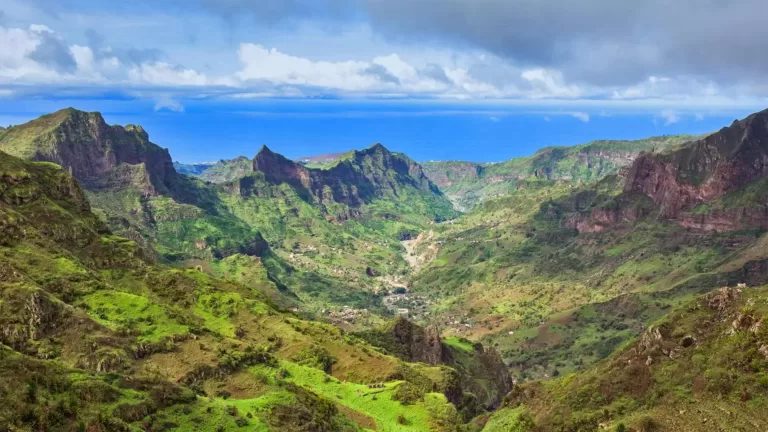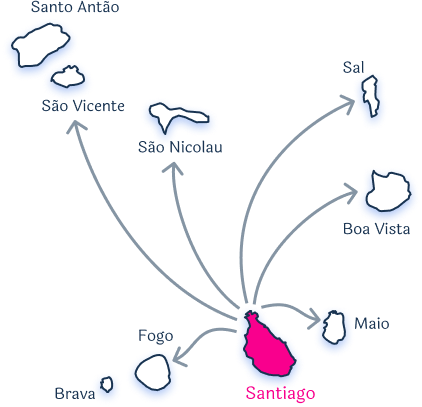The Island Santiago in Cabo Verde
On the island of Santiago begins the story of Cabo Verde with its varied landscape and beautiful views, colorful colonial houses. The African atmosphere, lively nightlife, and the old town Cidade Velha, which is on the World Heritage List UNESCO.
The landscape in Santiago is very varied. In the north and southeast, you can find black sand beaches, while the center of the island is characterized by great mountains and exotic valleys. In the south and east, the sail is fertile and with banana plantations.

The History of Santiago
Santiago was first settled by the two discoverers of the islands, António de Noli and Diogo Gomes. Together with a small group of settlers from the Algarve in Portugal, they settled in 1462. The city soon grew and the business of supplying ships and trading slaves flourished. The other islands, with the exception of Fogo, remained unexplored or were used only for salt production or pasture.
Early on, Santiago had close ties to West Africa. When rebalius and other African renegades escaped miscegenation. In the 20th century, rebellion stirred mainly in São Nicolau and São Vicente, but Santiago also had its uprisings – and produced the islands’ first great poet and dissident, Jorge Barbosa.
Today, Praia is the political center of Cape Verde, which continues to experience enormous expansion, while the infrastructure cannot keep pace with the development. In the south, the island is changing rapidly with a new ring road, some huge housing estates, shopping centers, and hotels. The same is true for the general expansion of the city and related services, from universities to sewage treatment plants. New roads have also been completed recently in the north, but the silence there is reminiscent of rural Africa. Here, the pace of life is slower, permeated by donkeys and carts, pigs, chickens, dogs, and goats. Much of Cabo Verde’s economic development takes place in Santiago, where many foreign NGOs work on various projects. These are specifically designed to boost the economy, improve infrastructure and raise living standards.
The Weather in Santiago
Santiago how to get there?
There are few direct flights from some European countries, but you can always take a connecting flight. Check flight schedules regularly as they can change throughout the year. Also, make sure you have enough time to catch your connecting flight or book a hotel so you can continue flying the next day.
Flights to Santiago
International flights to São Vicente
International flights are rare and it is advisable to keep checking as they can change throughout the year. Direct flights between Praia and Paris are only available in winter and to Amsterdam and Praia only in summer. The same is true for flights between Praia and Casablanca – Morocco with Royal Air Maroc. There are more frequent direct flights to and from Lisbon and Gran Canaria. There are also direct flights to Senegal and Guinea-Bissau, and even to Fortaleza and Recife in Brazil in late summer. Before COVID -19, there were also summer flights to Providence in Rhode Island in the USA. But these connections have not yet been resumed.
- Portugal - Lisbon LIS
- Gran Canaria
- The Netherlands - Shiphol Amsterdam
- France - Paris Orye
- Dakar RAI
- Guinea Bissau OXB
- Ponta Delgada PDL
- Morocco - Casablanca CMN

Domestic flights to São Vicente
Domestic flights can be booked with Cabo Verde airlines. Now after COVID -19 not all connections are restored yet. We will try to update regularly.
- Boa Vista BVC
- Fogo - São Filipe SFL
- Maio MMO
- Sal - SID
- São Nicolau SNE
- São Vicente VXE

Transportation by sea to Santiago
Take a ferry to Santiago
You also can get to Santiago by ferry. For example, from the island of Brava and Fogo. The ferry ride can take a while. Departures of the ferry are north of the port. connections to São Vicente and São Nicolau are still in the works.
Take a yacht to Santiago
Praia has a well-protected harbor where you can anchor in the west between the two jetties. It is important that you comply with all entry formalities with the port captain and immigration, even if it is not your first stay in Cabo Verde. Upon departure, you will receive clearance from the port captain.
The next best anchorage is Tarrafal, on the north of the island. Here many yachts are anchored. Another anchorage is in Ribeira da Barca. Note that the swell and the northeast winds blow from the island.
Getting around in Santiago
Taxi
When you take a taxi from the airport to the capital Praia this will cost you around 10 euros. depending on the journey length a trip to port or back from Praia will be about cost 2000$ to 5000$. Taxis can be found everywhere in Praia. They are clearly marked and cream-colored. They honk at anyone who looks remotely like a tourist, hoping for a fare. A ride within the city costs 150$ to 300$, sometimes more, especially after 11 pm. A cab for the whole day costs about 8,000$. There are no cab companies, only individual owners/drivers, so have your hotel book you one or hail one on the street.
Festivals at Santiago
Like every island in Cabo Verde, Santiago has its own festivals every year. Locals and tourists come together to enjoy the festivities.
